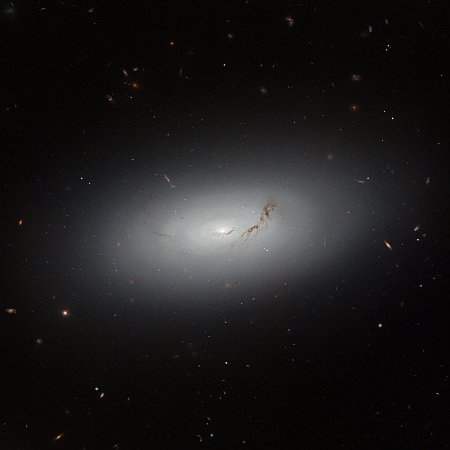A galactic cloud
Cool image time! The picture to the right, cropped, reduced, and sharpened to post here, was taken by the Hubble Space Telescope. It shows what scientists dub a lenticular galaxy, with features that put it somewhere between a spiral galaxy and an elliptical (which has no structure a appears instead a cloud of stars), sitting about 73 million light years away.
NGC 3156 has been studied in many ways … from its cohort of globular clusters, to its relatively recent star formation, to the stars that are being destroyed by the supermassive black hole at its centre.
Why this galaxy has no spiral arms is somehow related to its age and its central black hole, but the detailed theories that astronomers have to explain this are far from confirmed.
The image is interesting also because of its lack of foreground stars or background galaxies. Its location in the sky explains this, as Hubble was looking at right angle to the Milky Way’s galactic plane, essentially looking directly into the vast emptiness between the galaxies.
On Christmas Eve 1968 three Americans became the first humans to visit another world. What they did to celebrate was unexpected and profound, and will be remembered throughout all human history. Genesis: the Story of Apollo 8, Robert Zimmerman's classic history of humanity's first journey to another world, tells that story, and it is now available as both an ebook and an audiobook, both with a foreword by Valerie Anders and a new introduction by Robert Zimmerman.
The print edition can be purchased at Amazon or from any other book seller. If you want an autographed copy the price is $60 for the hardback and $45 for the paperback, plus $8 shipping for each. Go here for purchasing details. The ebook is available everywhere for $5.99 (before discount) at amazon, or direct from my ebook publisher, ebookit. If you buy it from ebookit you don't support the big tech companies and the author gets a bigger cut much sooner.
The audiobook is also available at all these vendors, and is also free with a 30-day trial membership to Audible.
"Not simply about one mission, [Genesis] is also the history of America's quest for the moon... Zimmerman has done a masterful job of tying disparate events together into a solid account of one of America's greatest human triumphs."--San Antonio Express-News
Cool image time! The picture to the right, cropped, reduced, and sharpened to post here, was taken by the Hubble Space Telescope. It shows what scientists dub a lenticular galaxy, with features that put it somewhere between a spiral galaxy and an elliptical (which has no structure a appears instead a cloud of stars), sitting about 73 million light years away.
NGC 3156 has been studied in many ways … from its cohort of globular clusters, to its relatively recent star formation, to the stars that are being destroyed by the supermassive black hole at its centre.
Why this galaxy has no spiral arms is somehow related to its age and its central black hole, but the detailed theories that astronomers have to explain this are far from confirmed.
The image is interesting also because of its lack of foreground stars or background galaxies. Its location in the sky explains this, as Hubble was looking at right angle to the Milky Way’s galactic plane, essentially looking directly into the vast emptiness between the galaxies.
On Christmas Eve 1968 three Americans became the first humans to visit another world. What they did to celebrate was unexpected and profound, and will be remembered throughout all human history. Genesis: the Story of Apollo 8, Robert Zimmerman's classic history of humanity's first journey to another world, tells that story, and it is now available as both an ebook and an audiobook, both with a foreword by Valerie Anders and a new introduction by Robert Zimmerman.
The print edition can be purchased at Amazon or from any other book seller. If you want an autographed copy the price is $60 for the hardback and $45 for the paperback, plus $8 shipping for each. Go here for purchasing details. The ebook is available everywhere for $5.99 (before discount) at amazon, or direct from my ebook publisher, ebookit. If you buy it from ebookit you don't support the big tech companies and the author gets a bigger cut much sooner.
The audiobook is also available at all these vendors, and is also free with a 30-day trial membership to Audible.
"Not simply about one mission, [Genesis] is also the history of America's quest for the moon... Zimmerman has done a masterful job of tying disparate events together into a solid account of one of America's greatest human triumphs."--San Antonio Express-News



For it to reach the disk stage it must have some rotation.
And I think I can see arms starting to form inside the disk.
Its a beautiful galaxy though.
There is a ring of dust around the core that’s faint but indicates there may be some circular rotation. I agree with you pzatchok.
This may be a stretch, but the gas cloud that’s the dominant feature may have been formed by the small remnant of the galaxy on the upper left of the picture (it appears close to the galaxy because it’s also in focus)
If it passed through? creating the gas cloud at an angle as it appears now, on the other side of the galaxy, millions of years ago before the galaxy rotated away from the intruder?
This might be evidence that irregular galaxies also have some rotation.